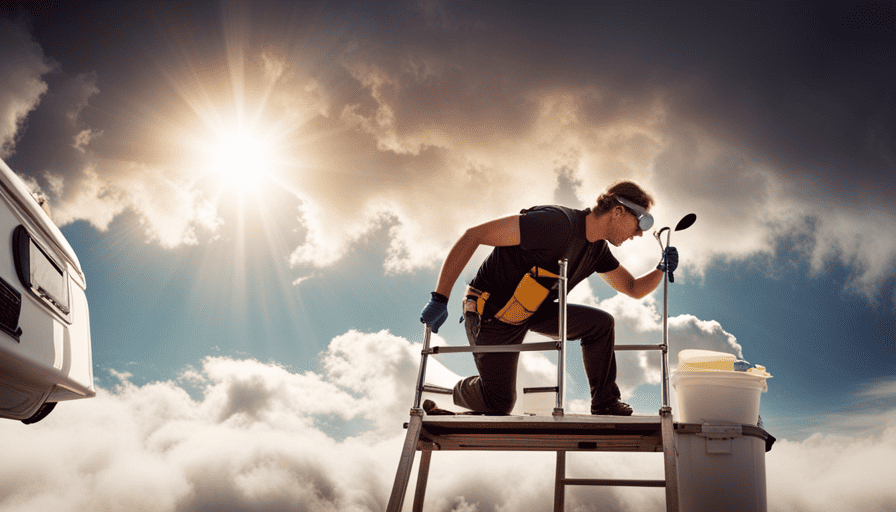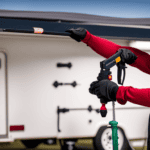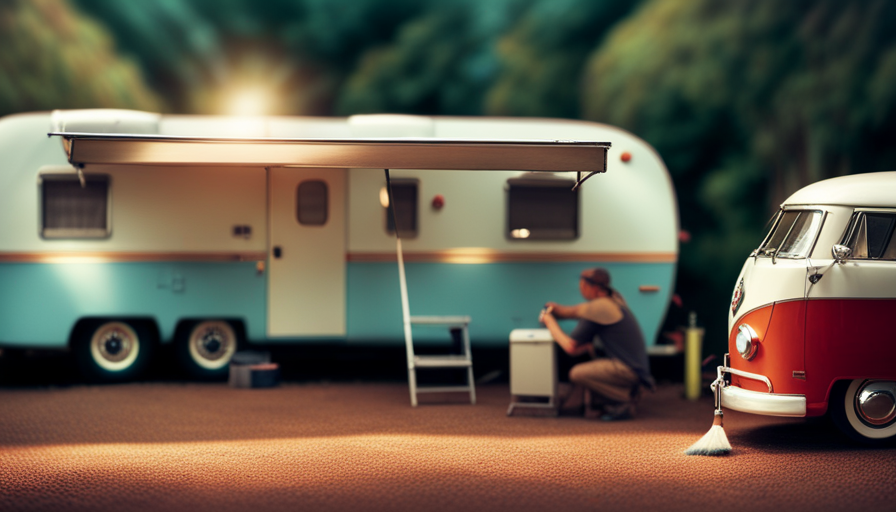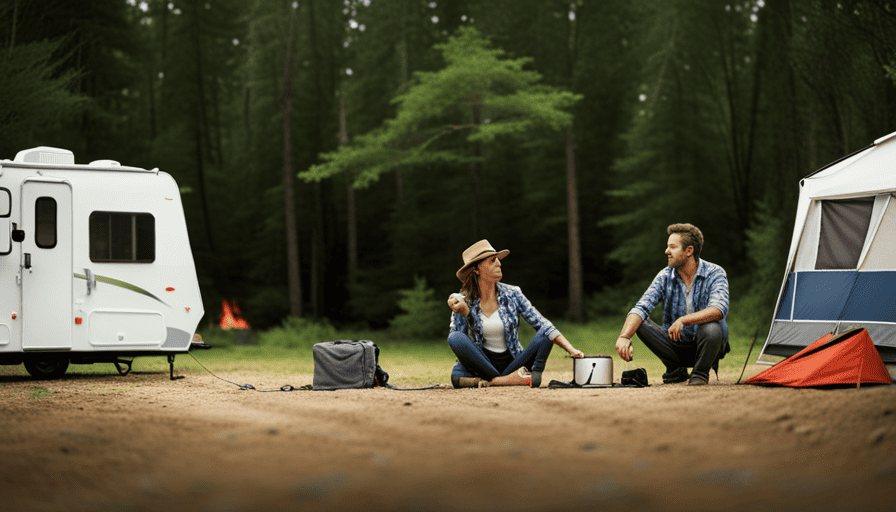You might be under the impression that repairing a camper roof is an overwhelming project. However, believe me, it’s not as difficult as it appears. Indeed, armed with some basic understanding and the appropriate equipment, you can effortlessly fix your camper roof, guaranteeing a camping adventure without any leaks.
Now, you might be wondering if it’s worth the effort. After all, why not just take it to a professional? Well, I’ll tell you why.
Not only will repairing your camper roof save you money, but it will also give you the satisfaction of knowing that you can take care of your own RV.
In this article, I will guide you through the step-by-step process of fixing your camper roof. From assessing the damage to replacing damaged roofing material, I’ll provide you with all the information you need to successfully complete the repair.
So, grab your tools and let’s get started on restoring your camper roof to its former glory.
Key Takeaways
- Assess the damage before starting the repair process, looking for cracks, holes, loose seams, and signs of water damage.
- Gather the necessary tools and materials for the repair and familiarize yourself with different roof repair techniques.
- Choose the right materials for the camper roof, such as rubber, aluminum, or fiberglass, based on durability and weather resistance.
- Regularly inspect and maintain the camper roof to address weak areas, reinforce structure and seams, and prevent future damage.
Assess the Damage
Take a deep breath and survey the extent of the damage to your camper’s roof. Assessing the damage is crucial before you can begin fixing it.
Start by carefully examining the roof for any cracks, holes, or loose seams. Look for signs of water damage, such as discoloration or soft spots. Inspect the roof vents, air conditioner unit, and any other protrusions for any signs of damage. It’s important to identify all areas that need repair to ensure a thorough fix.
Once you have assessed the damage, you can take steps to prevent future damage. Consider the cause of the damage, such as heavy rain or falling debris, and take measures to protect your camper’s roof from similar incidents in the future. This may include installing a weatherproof cover or reinforcing weak areas. Additionally, regularly inspecting and maintaining your roof can help prevent future damage.
Now that you have assessed the damage and determined the necessary repairs, it’s time to gather the necessary tools and materials.
Gather the Necessary Tools and Materials
First, make sure you have all the tools and materials needed to tackle this project. Can you imagine the satisfaction of completing the job with everything you need right at your fingertips? When it comes to camper roof repair, having the right tools and materials is crucial.
Here are three essential items you’ll need:
-
Roof repair techniques: Familiarize yourself with various roof repair techniques before starting the project. Whether you need to patch a small hole or replace an entire section of the roof, knowing the right technique will ensure a successful repair.
-
Choosing the right materials: Selecting the correct materials is equally important. Consider the type of camper roof you have and choose materials that are compatible. Common options include rubber, aluminum, and fiberglass. Additionally, ensure you have the necessary adhesives, sealants, and fasteners to complete the repair.
-
Safety equipment: Don’t overlook the importance of safety. Prioritize your well-being with safety goggles, gloves, and a sturdy ladder. These will protect you from potential hazards during the repair process.
With all the tools and materials gathered, you’re ready to move on to the next step. Now that you’re fully equipped, it’s time to clean and prepare the roof surface for repair.
Clean and Prepare the Roof Surface
Now that I have all the necessary tools and materials at my disposal, it’s time to ensure the surface of my camper’s roof is clean and properly prepared for the upcoming repair.
Preparing the surface is a crucial step in fixing a camper roof, as it ensures proper adhesion of the repair materials and increases the longevity of the fix.
To begin, I will thoroughly clean the roof surface using a mild detergent or cleaner specifically designed for RV roofs. This will remove any dirt, grime, or oxidation that may hinder the adhesive’s effectiveness. I’ll scrub the surface gently with a soft-bristled brush to avoid damaging the roof.
Once the roof is clean, I’ll rinse it thoroughly with water to remove any residue from the cleaning solution. It’s important to allow the roof to dry completely before moving on to the next step, as any moisture can interfere with the adhesive bonding process.
After the roof surface is clean and dry, I’ll apply the adhesive according to the manufacturer’s instructions. This may involve spreading the adhesive evenly over the entire roof or applying it in specific areas where repairs are needed. I’ll make sure to follow the recommended curing time before proceeding to the next step.
Now that the roof surface is clean and the adhesive’s been applied, it’s time to move on to repairing small holes and cracks.
Repair Small Holes and Cracks
After ensuring the surface is clean and dry, I can proceed to patching any small holes or cracks using a suitable repair material. Repairing small holes and cracks in a camper roof is an essential step in maintaining its integrity and preventing further damage.
To effectively repair these imperfections, there are several techniques that can be employed. One common method is to use a roof sealant or adhesive specifically designed for RV roofs. These products are typically made of durable materials that can withstand the elements and provide a long-lasting repair.
Before applying the sealant, it’s important to clean the area thoroughly and remove any loose debris or old sealant. Once the surface is prepared, the sealant can be applied using a putty knife or a caulking gun, depending on the size of the hole or crack. It’s important to ensure that the sealant is applied evenly and covers the entire damaged area.
In addition to repairing existing holes and cracks, it’s also important to take preventative measures to avoid future damage. This can include regularly inspecting the roof for any signs of wear or damage, such as loose seams or deteriorating sealant. By addressing these issues promptly, you can prevent them from developing into larger problems.
With the small holes and cracks repaired, the next step is to replace any damaged roofing material.
Replace Damaged Roofing Material
To maintain the structural integrity of the vehicle, it’s crucial to promptly replace any roofing material that’s been damaged. When it comes to camper roofs, there are various types of roofing materials available, such as rubber, aluminum, or fiberglass. Here are four important things to consider when replacing damaged roofing material on your camper:
-
Choose the right roofing material: Depending on your camper’s needs and budget, select a roofing material that’s durable, lightweight, and weather-resistant. Consider factors like maintenance requirements and lifespan.
-
Measure and cut accurately: Before installing the new roofing material, measure the damaged area precisely and cut the replacement piece accordingly. This will ensure a seamless and secure fit.
-
Remove the old material: Carefully remove the damaged roofing material, making sure not to damage the underlying structure. Use appropriate tools and techniques to avoid any further harm.
-
Install the new roofing material: Apply adhesive or sealant as recommended by the manufacturer and carefully place the new roofing material in position. Press firmly to ensure proper adhesion and alignment.
By following these steps, you can replace damaged roofing material on your camper and ensure its longevity. Once the new material’s securely installed, it’s important to seal and waterproof the roof to protect it from future damage and leaks.
Seal and Waterproof the Roof
Once you’ve successfully replaced the damaged roofing material, it’s crucial to seal and waterproof the roof to safeguard against future damage and leaks. Waterproofing techniques are essential to protect your camper roof from common problems such as water infiltration and deterioration. There are several effective methods you can use to seal and waterproof your camper roof.
Firstly, consider using a high-quality waterproof sealant specifically designed for RV roofs. Apply the sealant generously to all seams, joints, and around any vents or protrusions on the roof. This will create a watertight barrier that prevents moisture from seeping into the camper.
Another effective waterproofing technique is to apply a rubberized roof coating. This coating forms a durable, flexible membrane that provides an additional layer of protection against water damage. It also helps to reflect sunlight and reduce heat buildup on the roof.
It’s important to regularly inspect and maintain your camper roof to address any potential weak areas. Reinforcing weak areas with additional sealant or patching up small cracks and holes can prevent future problems.
By following these waterproofing techniques and addressing common roof problems, you can ensure that your camper roof remains in excellent condition for years to come. In the next section, we will discuss how to reinforce weak areas for added durability and protection.
Reinforce Weak Areas
To ensure the longevity and durability of your camper roof, it is essential to reinforce weak areas. Strengthening the structure of the roof is crucial to prevent potential damage caused by heavy rain, strong winds, or other external factors.
One effective way to reinforce weak areas is by adding additional support beams or braces. These can be strategically placed in areas where the roof may be prone to sagging or buckling under pressure.
Additionally, reinforcing seams is another important step in maintaining a strong camper roof. By using a high-quality sealant or adhesive, you can strengthen the bond between the seams and prevent water from seeping through.
To achieve the best results, here are three key tips to follow:
- Inspect the entire roof carefully to identify any weak areas or signs of damage.
- Use strong and durable materials when reinforcing the structure and seams.
- Follow the manufacturer’s instructions and guidelines to ensure proper installation.
By reinforcing weak areas and strengthening the structure and seams of your camper roof, you can significantly increase its lifespan and protect it from potential leaks. This will give you peace of mind during your camping adventures and keep your camper in top-notch condition.
In the next section, we will discuss how to test for leaks and ensure that your camper roof is fully waterproof.
Test for Leaks
After reinforcing weak areas on your camper roof, the next step is to test for leaks. This is an important part of regular roof maintenance, as even the smallest leak can lead to significant damage if left untreated.
There are several common causes of leaks in camper roofs, such as damaged or deteriorated seals around vents, skylights, or antennas, as well as cracks or punctures in the roof itself.
To test for leaks, start by thoroughly cleaning the roof surface and removing any debris. Then, use a hose to spray water onto different sections of the roof, paying close attention to the areas where leaks are most likely to occur. Allow the water to flow over the surface for a few minutes, checking the interior of the camper for any signs of water intrusion. Look for water stains, dampness, or musty odors, as these can indicate the presence of a leak.
If you do find a leak, mark the area and take note of its location. This will help you when it comes time to repair the roof.
Once you have finished testing for leaks, it’s important to maintain and regularly inspect the roof to prevent further damage and ensure the longevity of your camper.
Maintain and Regularly Inspect the Roof
Regularly maintaining and inspecting your camper’s roof is crucial to ensure its long-lasting protection and peace of mind. Regular maintenance is key to preventing costly repairs down the road. Here are some important steps to keep in mind:
-
Clean the roof: Remove any debris, dirt, or leaves that may have accumulated on the roof. This will prevent water from pooling and causing damage.
-
Check for cracks or tears: Inspect the roof carefully for any signs of cracks or tears. These can lead to leaks and water damage if left unattended.
-
Seal any openings: Make sure to seal any openings, such as vents or skylights, with a high-quality sealant. This will prevent water from seeping in.
-
Inspect the seams: Pay close attention to the seams and edges of the roof. These areas are prone to wear and tear and may require additional sealing or repair.
-
Trim overhanging branches: If there are any trees or branches hanging over your camper’s roof, trim them back. This will prevent them from causing damage during storms or high winds.
Regularly maintaining and inspecting your camper’s roof is essential to enjoying a leak-free camping experience. By following these simple steps, you can ensure that your roof remains in top condition and provides the protection you need for years to come.
Enjoy a Leak-Free Camping Experience
I can now relax and enjoy my camper without worrying about roof leaks thanks to the steps I took to fix it.nnI take pride in my DIY camper roof repair skills and feel confident in my ability to maintain and regularly inspect the roof to ensure it stays leak-free.nnIt’s a great feeling knowing that I have taken the necessary precautions to protect my camper and can now fully enjoy my camping experience.
Relax and enjoy your camper without worrying about roof leaks
Why not sit back, relax, and enjoy your camper without worrying about roof leaks? Here are some tips to prevent roof leaks in your camper and choose the right roofing material.
-
Regular maintenance: Inspect your camper roof regularly for any signs of damage or wear. Fix any small issues before they become bigger problems.
-
Choose the right material: Consider the climate and your camping habits when selecting roofing material. Options like rubber, fiberglass, or aluminum can provide durability and protection against leaks.
-
Proper installation: Ensure that your roof is installed correctly, with proper sealing and flashing, to prevent water from seeping in.
-
Clean and clear: Keep your camper roof clean and free from debris, as clogged gutters or drains can lead to water pooling and potential leaks.
By following these tips, you can relax and enjoy your camper worry-free, knowing that your roof is in good condition. So, take pride in your DIY camper roof repair skills and continue maintaining your camper for many enjoyable trips to come.
Take pride in your DIY camper roof repair skills
After learning about how to relax and enjoy my camper without worrying about roof leaks, I’m now excited to share my DIY camper roof repair skills. I take pride in my ability to fix my camper’s roof, which not only saves me money but also gives me a sense of accomplishment.
When it comes to DIY camper roof repair, there are a few ideas and tips that I’ve found to be extremely helpful.
Firstly, it’s important to thoroughly inspect the roof for any damage or potential leaks. Then, I recommend using high-quality materials and following a step-by-step guide to ensure a successful repair.
Additionally, properly sealing and maintaining the roof is crucial for long-term durability.
With these DIY camper roof ideas and tips, I’m confident that anyone can tackle their camper roof repair with ease and confidence.
Frequently Asked Questions
How long does it typically take to clean and prepare the roof surface before starting the repair process?
Typically, it takes around 1-2 hours to clean and prepare the roof surface before starting the repair process. However, the duration may vary depending on the condition of the roof and the extent of the cleaning required. It’s advisable to use specific cleaning solutions designed for camper roofs, as regular household cleaning products may not be effective or could potentially damage the surface. These specialized solutions are formulated to remove dirt, grime, and any other contaminants without causing harm.
Can I use regular household cleaning products to clean the camper roof, or do I need to purchase specific cleaning solutions?
I highly recommend using specific cleaning solutions that are designed for camper roofs. Regular household cleaning products may not be suitable for this task and could potentially damage the roof surface. These specialized cleaning solutions are formulated to effectively remove dirt, grime, and other contaminants without causing any harm. They’re designed to be gentle yet effective, ensuring a thorough and safe cleaning process for your camper roof.
Is it necessary to replace the entire roofing material if only a small section is damaged, or can I just patch it up?
If only a small section of your camper roof is damaged, it’s not always necessary to replace the entire roofing material. In many cases, you can simply patch up the damaged area. Roof patching involves repairing the specific section that’s affected, providing a cost-effective solution. However, it’s important to assess the extent of the damage and consult a professional to determine if roof replacement is necessary for long-term durability and safety.
How often should I test for leaks after completing the repair process?
After completing the repair process on my camper roof, it’s important to test for leaks regularly. The testing frequency will depend on various factors such as the age and condition of the roof, as well as the weather conditions it’s exposed to. I recommend testing for leaks at least once every six months to ensure any potential issues are detected early.
Common repair mistakes include improper sealing and inadequate patching, so thorough testing is crucial to ensure the roof remains watertight.
Are there any specific maintenance procedures I should follow to ensure the longevity of my camper roof?
To ensure the longevity of your camper roof, it’s crucial to follow specific maintenance procedures.
Common roof problems, like leaks and cracks, can be prevented by regularly inspecting and cleaning your roof.
Additionally, choosing the right roof coating for your camper is essential. Look for a durable and weather-resistant coating that suits the material of your roof.
By taking these precautions, you can protect your camper roof and extend its lifespan. Remember, prevention is key when it comes to maintaining your camper roof.
Can Camper Delamination be Fixed Using the Same Methods as Repairing a Camper Roof?
When it comes to fixing camper delamination, the methods used may not be exactly the same as repairing a camper roof. Camper delamination often involves addressing the separation of the fiberglass layers, while roof repair focuses on sealing leaks and replacing damaged materials. Therefore, fixing camper delamination may involve specialized techniques to address the specific issue.
Conclusion
After following these steps to fix my camper roof, I can confidently say that my camping experience will be leak-free and enjoyable.
Assessing the damage and gathering the necessary tools and materials were crucial in preparing for the repair process.
By cleaning and preparing the roof surface, repairing small holes and cracks, and replacing damaged roofing material, I reinforced weak areas and ensured the longevity of my roof.
Regularly inspecting and maintaining the roof will guarantee its durability.
So, set off on your next camping adventure with a sturdy and secure roof.



















